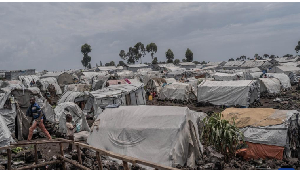- Home - News
- TWI News | TV
- Polls
- Year In Review
- News Archive
- Crime & Punishment
- Politics
- Regional
- Editorial
- Health
- Ghanaians Abroad
- Tabloid
- Africa
- Religion
- Election 2020
- Coronavirus
- News Videos | TV
- Photo Archives
- News Headlines
- Press Release
Business News of Saturday, 30 October 2010
Source: Business Analyst
Engineering, MDGs And National Dev't
(Concluding Part)
Continued from last week
By Dr. Robert Adjaye
LESSONS FROM THE ASIAN TIGERS: The key to this developmental challenge is
to maximize economic efficiency by using technically literate workforce (to run
modern technologies), and the skills of engineers to develop efficient and
reliable national infrastructure (water supply, transport, energy supply, waste
management etc.). These are some of the key lessons from the Asian Tigers.
First: The development plans and objectives must be suitable and appropriate for
the particular country’s circumstances and needs.
Second: Governments must be facilitators by creating the right environment, and
in some cases even intervene directly, to achieve these developmental objectives
Third: High investment in human capital development, especially science,
engineering and technology, is a pre-requisite for sustainable growth. In
India, engineering colleges and business schools have been growing at about 20%
and 60% per year, respectively.
Fourth: Governments must implement policies to achieve sustained and rapid
economic growth to develop the infrastructure, create new business
opportunities, higher incomes, and increased wealth. This requires capable and
effective management of the macro economy and the private sector, and export
oriented economic growth.
Fifth: Sustained economic growth requires strong governments and leaders
committed to national, not personal interests, over a sustained period of time
and promotion of competition to stimulate innovation.
Sixth: The eradication of poverty requires two broad types of strategies:
expansion of the economy and government-run affirmative action programmes
targeted to the poor.
THE ENGINEER AND SUSTAINABLE GROWTH: In looking at the future, we need to have a
better understanding of how building the human capital base of engineering
expertise is inextricably linked with sustainable growth, engineering
renaissance and national development. Human resources are the most sustainable
resources any nation has, and so the priority for developing nations should be
how to make engineering appropriate and sustainable.
Engineering Education and Training: When considering engineering education and
training and the future role of engineers, it will be instructive to refer to a
definition and quotation from the USA National Academy of Engineering. It
states:
“Engineering is problem recognition, formulation, and solution. In the next 20
years, engineering and engineering students will be required to use new tools
and apply ever-increasing knowledge in expanding engineering disciplines, all
while considering societal repercussions and constraints within a complex
landscape of old and new ideas. ….. The engineers of 2020 will be actively
involved in political and community arenas. They will understand workforce
constraints, and they will recognize education and training requirements
necessary for dealing with customers and the broader public. Engineering will
need to expand its reach and thought patterns and political influence if it is
to fulfill its potential to help create a better world for our children and
grandchildren.
Thus we need to refocus our attention on the production of sufficient number of
engineering expertise, capable of problem recognition, formulation and solution,
if we are to ensure sustainable economic growth and attainment of the MDGs.
Tertiary Education and Human Capacity Building: “National development and
corporate growth, higher standards of living are all inextricably tied up with
technological advancement. Developing countries need a technologically educated
work force and society. This should commence with a solid grounding in science
and mathematics so that students can make informed choices later in their
further education. There is the need for improved technical literacy. This
should include among other things, a hands on learning approach, with reference
to application of engineering in real life and its contribution to the societal
good, making engineering fashionable, creation of better incentives with tax
concessions for firms offering training facilities for students, and commercial
exploitation of research findings.
Science, mathematics and engineering must be packaged as “fashionable” subjects
and not necessarily perceived as difficult and boring subjects to be avoided.”
Engineering Population: Strong performing economies, e.g. India,
China, Malaysia , Turkey and South Korea , etc. have one thing in common, i.e.
a commitment to engineering. In 2002, the OECD national mean criteria for the
proportion of total graduates with higher level tertiary qualifications and
lower level engineering qualifications were 13.3% and 16.3%, respectively.
Rapidly developing countries such as South Korea and China have much higher
proportions – around one-third in engineering.
As stated in the World Development Report 2005 and 2002 OECD report, a strong
Science, Engineering and Technology (SET) base is necessary for development.
This requires increased number of engineers per population. The estimate of
about one Ghanaian engineer for about 13,000 people compares less favourably
with that of one engineer for about 300 Japanese, and an Indian average of one
engineer for about 160 people. A sizeable increase in the number of engineers
will require Government to make changes to school curricula by providing solid
grounding in science and mathematics to enable students make informed choices
later in life. School curricula should include, inter alia, practical works
with references to the application of engineering to real life situations and
its contribution to the public good.
In conclusion, we need to draw lessons from the experience of both developed and
emerging economies and adapt them to local conditions to build the human capital
necessary for engineering renaissance, sustainable growth and national
development. This includes:
Increased investment in human capital with emphasis on Science, Engineering and
Technology (SET) to cope with national development plans and global
technological challenges.
Revision of school syllabi using wherever possible local and practical examples,
to make mathematics, science and engineering relevant and 'fashionable'.
Creation of a Presidential Commission on Science, Engineering and Technology and
adoption of an appropriate national SET policy.
Enactment of an Engineering Bill to regulate the practice of engineering to
promote the growth of domestic engineering skills, industries and local content
in the oil/gas industry.
Training of engineers should place as much emphasis on development of
entrepreneurship, managerial and leadership skills as on the normal core
engineering subjects.
Engineers should be responsive to the milieux they operate in, and be prepared
to assume a leading role in formulating national policies and activities to
create the renaissance engineer and a buoyant economic and sustainable national
development.
Government should support Science, Engineering and Technology by introducing tax
incentives for training of students and graduates, and venture capital for
commercial exploitation of research findings.
Government can facilitate growth by selecting certain key areas and challenging
engineers to come up with solutions while at the same time identifying and
supporting all the interlinking businesses.
Lastly, Ghanaians should be prepared to make the necessary attitudinal change to
embrace the search for engineering capital building, excellence and renaissance
for sustainable national development and prosperity.
The Author, Dr. Robert Adjaye is an Engineering Consultant and Past President of
The Ghana Institution of Engineers. He is also the Rector of The Petroleum
Skills Development Institute in Accra. E-mail: radjaye@yahoo.com
The Business Analyst










